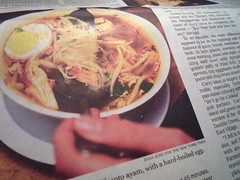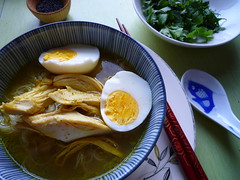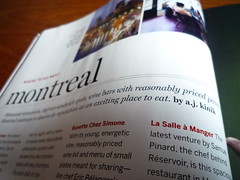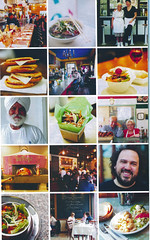 fig. a: theirs
fig. a: theirs
I've never been all too sure about that "a picture is worth a thousand words" jazz. What I do know is that a picture--the right picture--can activate a thousand taste buds (or something thereabouts) sometimes. Especially when it's eight o'clock at night, and you haven't eaten since you had that measly PB & J at noon, and your Montreal-bound "express" bus is crawling along in a snowstorm, and (as a result) you've probably got a good two hours until mealtime.
That's what happened the other night, when I reached The New York Times' Dining section and Julia Moskin's ecstatic report on that tantalizing family of Southeast Asian curry noodle soups known by such monikers as curry laksa, curry mee, la sa ga, khao poon, and soto ayam ("From Asia, Rapture in a Bowl," January 7, 2009). It wasn't the front page picture of Rosa Michelman digging in to a bowl of soto ayam at Minangasli, an Indonesian restaurant in Queens' Elmhurst neighborhood; it was the medium close-up of Michelman's soto ayam on page D4, the one you see above, the one that came with the caption "Indonesian Penicillin."
Moskin's opening paragraph drive-by on your standard-issue Western paradigm chicken soup seemed a bit excessive ("Purists find pleasure in a clear, golden broth with a few perfect dice of carrot and egg noodles, but the taste? Dull, honestly. Bland, even."), and I wasn't exactly sure that I wanted to join her and "bathe in" the pleasures of a category of soups she described as "the love children of Indian curries and Chinese noodle soups," but I knew what she was getting at when she described their seductive combination of ginger, lemon grass, cinnamon, black pepper, and turmeric, their "sweet, spicy, and fragrant" broth, their "springy noodles and a madness of garnishes." In fact, I started to have visions. Visions of New York, Vancouver, and Singapore. I was already pretty hooked by the time I reached Part 2 of the article, but it was that photograph that cinched it. There's was absolutely no question about it. That was what we were going to be having for dinner the next night, and I was positive Michelle would wholeheartedly agree once she too laid eyes on it. I was right.
In case you haven't figured it out, Moskin's thesis is that you're even remotely prone to seeking the curative and restorative powers of chicken-noodle soup, you should check out a bowl of Southeast Asian chicken curry noodle soup, where whatever medicinal potential that combination of chicken, noodles, and broth might hold is augmented by a combination of tropical ingredients bordering on the hallucinatory.
We didn't need any convincing. Sure enough, the next day, there we were, simmering, grinding, and assembling our way to our very first homemade Indonesian chicken curry noodle soup.
Moskin's article featured two different versions of curry noodle soup: one with coconut milk and one without. We opted for the one without, an "Indonesian chicken soup with noodles and aromatics" adapted from James Oseland's (of Saveur fame) Cradle of Flavor, again, largely because of the photograph, even though there was no direct connection (Oseland doesn't cook at Minangasli).
The recipe featured almost twenty ingredients, many of them fairly exotic, many of them perhaps a bit difficult to find in an area that doesn't have a few good Asian specialty food stores. But if you do happen to live in such an area (and Montreal certainly qualifies), making your own batch of soto ayam is dead easy. The New York Times recipe stated that it would take about an hour and fifteen minutes, start to finish, and that was pretty much what we experienced. None of the techniques involved were difficult either. You just had to able to locate all the necessary ingredients.
And we were very glad we did. From the time we fried up that freshly prepared curry paste, we had a feeling this was going to be a doozy. Minutes later, when we added the curry paste to our chicken broth, there was no doubt. Ten minutes later, when we assembled our steaming bowls of noodles, shredded chicken, boiled eggs, broth, and herbs, we were besides ourselves with anticipation.
Can you blame us?
 fig. b: ours
fig. b: ours
I think Michelle put it best when she looked up from her steaming bowl and said, "Are you kidding me?"
Fighting off colds never tasted so good.
Soto Ayam, or Indonesian Chicken Soup with Noodles and Aromatics
1 free-range chicken, about 3 pounds, cut into quarters
2 stalks fresh lemon grass, bruised with the handle of a heavy knife
6 kaffir lime leaves, fresh or frozen (optional)
1 tsp kosher salt, more to taste
1 tsp black peppercorns
1 1/2 tbsp coriander seeds
2 tsp cumin seeds
5 shallots, peeled and halved
3 cloves of garlic, peeled
1 1/2 tsp ground turmeric
2 tbsp finely minced fresh ginger
3 tbsp peanut oil or canola oil
4 ounces glass noodles or thin dried rice noodles
1 tbsp fresh lime juice
2 tbsp chopped mint and cilantro leaves
2 eggs, boiled, peeled, and halved
2 shallots, thinly sliced and fried in vegetable oil until brown (optional)
quartered limes and chili paste for serving
Place the chicken in a medium pot with the lemon grass, the lime leaves, the salt and 2 quarts of water. Bring to a boil over high heat. Skim off any foam and reduce heat to a simmer. Cover and simmer until the chicken is tender, roughly 45 minutes, skimming as necessary.
Remove the chicken pieces from the broth and set aside. Remove and discard the lemon grass and lime leaves and reserve the stock in the pot. When the chicken is cool enough to handle, discard the skin and bones and shred the meat into bite-sized pieces.
Meanwhile, combine the peppercorns, coriander seeds and cumin seeds in a small food processor or spice grinder. Pulse until ground. Add the halved shallots, the garlic, the turmeric and ginger and pulse to a thick paste. You may need to do this in batches. You may also have to add a little water to help things along.
Heat the peanut oil in a medium saucepan over high heat. When the oil is very hot, add the spice paste and cook, stirring until the paste is cooked and beginning to separate from the oil, roughly 5 minutes.
Add the cooked curry paste and the chicken meat to the stock. Bring to a simmer and cook 10 minutes.
Cook the noodles according to the directions on the package, making sure not to overcook them.
Turn off the heat under the soup and add the lime juice. Taste for salt and adjust if necessary.
To serve, divide the noodles into large, deep soup bowls. Ladle chicken pieces and soup on top and sprinkle with herbs and the fried shallots, if using. Pass the extra lime wedges and the chili paste at the table.
Devour.
Serves 4.
[recipe based almost entirely on The New York Times' adaptation of a recipe by James Oseland, except for the boiled eggs, which came from that picture on D4]
Notes on sources: if you live in Montreal, Chinatown has several reliable sources; the Jean-Talon Market area is another good bet: there are a couple of good Asian specialty stores at Jean-Talon & St-Denis, and La Dépense is very strong on Southeast Asian; but you may also want to take a close look at what your local supermarket has in their Asian section: our local, Supermarché PA, has developed a surprisingly good Asian specialties section over the last couple of years, and Michelle got virtually everything we needed for this recipe there.
New note on sources: neither of us had been to Sakaris on St-Laurent (between Marie-Anne and Mont-Royal) for a while, but Michelle went there the other day and reports that they're now under new management (since the last time we were there, that is), and that they're strong on Asian specialty items, including kaffir lime leaves (!). Go figure.
aj
 fig. a: the new, improved G & T in the making
fig. a: the new, improved G & T in the making












